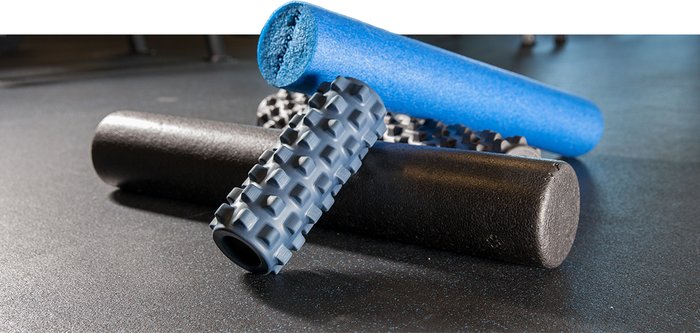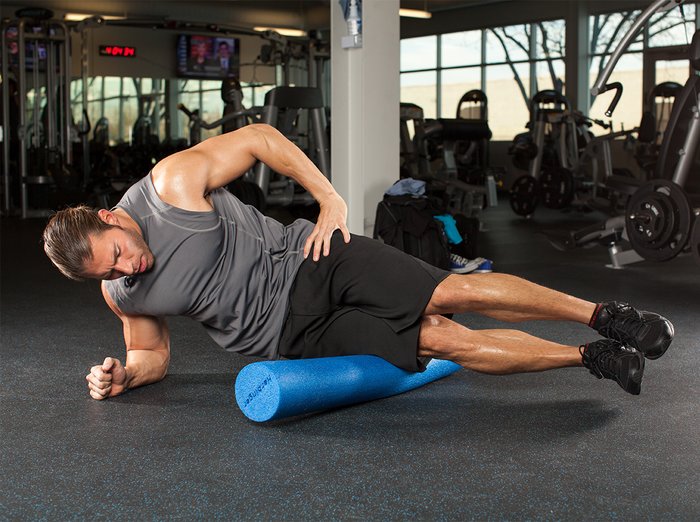Foam rolling has become incredibly popular over the last few years as more and more people are discovering they can practice better rehabilitation all on their own. It is a great way to mimic the benefits of a deep tissue massage, and promote faster recovery.
But, to get everything you can out of it, you need to perform your foam rolling properly. If you are guilty of these common errors, you may be doing more harm than good when you get that foam roller out.
Here are the six most common mistakes people make, and what you can do to avoid them.
Mistake 1: Not Using the Correct Roller
First things first, make sure that you're using the right foam roller. There are a variety of different options out there, both in terms of the size of the roller as well as the density and firmness it offers.
Beginners should start with a softer roller until their body gets used to the stress applied when rolling. From there, you can move on to firmer rollers, or even rollers with foam spikes, such as the Rumble Roller. These more advanced options, though indispensable to the experienced athlete, are often too aggressive for beginners and may do more harm than good.

You'll also want to consider the size of the area you plan to roll and match it to the roller being used. For example, to roll a larger muscle group, such as the hamstrings, look for a roller with a wider diameter so you can place enough pressure on those muscles to be effective.
On the other hand, a much smaller roller would be appropriate for a smaller muscle group, such as the forearm.
There are many options out there, so choose wisely. If you are serious about foam rolling, you might decide to have a few different rollers on hand so you can switch off according to what your muscles need.
Mistake 2: Rolling Too Quickly
You wouldn't want a massage therapist to zoom right over your sore muscles, so why would you do the same when foam rolling? There's a reason why therapists work slowly and deliberately, so take a page from the experts and don't rush.
Many people tend to rush through their foam rolling because it's painful and they just want it to be over with. This is a mistake. The more painful an area is, the more time you need to spend rolling that area.
The whole purpose of foam rolling is to release tense and knotted fascia around the muscle cells. This process takes time. If you go too fast, you'll only slightly increase blood flow to the region. This may provide some healing benefits, but isn't going to release the fascia, which is what will ultimately get you pain free and fully functional.
The bottom line: Take your time. If you feel rushed due to time constraints, wait and foam roll when you have the time to give it the attention it deserves. Relaxation is key to getting the results you desire, so don't rush.
Mistake 3: Foam Rolling Daily
You might have a tendency to think that the more often you foam roll, the better your results will be. Don't be fooled by this misguided mentality. Just as you would hit a muscle group hard in the gym one day and rest it the next day or two, the same applies to foam rolling.

Once you break down scar tissue and release the fascia, you need to give your body time to heal. If you're foam rolling every day, you'll begin to aggravate the area, eventually leading to more inflammation and more pain.
A good guideline to go by is to roll every other day. If you're still exceptionally sore when you go back to foam roll, give it another day or so. And, while you may still feel some pain due to the fact that your muscles are still tight, you shouldn't be more sore than you were the first time you rolled. If you are, that's a good indication you need to wait a bit longer before rolling again.
Mistake 4: Rolling in Only One Spot
Another common mistake is rolling only in the area where you feel pain. Your quad hurts so you foam roll right on top it, neglecting any surrounding areas. This should be avoided.
If you sit on the sore spot for too long with the roller (without moving back and forth along the tissues), there's a good chance you will aggravate the area and do more harm than good. Prolonged rolling in one area may cause bruising and increased inflammation, both of which will slow the healing process.
Also, sometimes the pain you feel is referred pain. This is a phenomenon where you experience pain in one area of the body, but the source of the pain is actually in another area entirely. So while you experience pain in your shoulder and attempt to rid it with foam rolling, the real issue could be a trigger point behind your shoulder in your rotator cuff. By neglecting this area, and just rolling in the spot that hurts, you may delay your recovery indefinitely.
So roll around and see what areas you can find that hurt. You might be surprised at how many different muscle groups are sore in and around the affected area.
Mistake 5: Poor Posture
Depending on the area, just the act of foam rolling alone can be hard work. You often find yourself placing a great amount of pressure on one area of the body, using just a few small muscles for support.
If you foam roll after a workout when you're already tired, you may find yourself getting sloppy with your form. Poor form during your foam rolling is a guaranteed way to decrease your results, and possibly lead to injury.

If you don't keep your spinal column in proper alignment and your body well supported, you may end up rolling muscles that are positioned poorly. This will result in increased soreness and potentially injury.
To resolve this, foam roll when you are feeling fresh and always make sure that you pay attention to your form. If your posture starts to slip, stop foam rolling and only pick up again when you can use good form.
Mistake 6: Forgetting to Breathe
Finally, the last foam rolling mistake to avoid is neglecting to breathe. Breathing prevents the muscles from tightening up and limiting your range of motion, which is why it's so important during stretching and yoga. Breathing while foam rolling helps relax the muscles and allow those deep muscle fibers to release as you roll.
Holding your breath is a common and automatic response when you feel pain, but doing this while foam rolling will only hinder the process.
Focus on breathing in and out as you foam roll. You'll usually find that once you do relax and breathe, it feels less painful to be on the roller. You'll also get better results.
Who knew a piece of foam could inflict so much pain? If you've experienced the benefits of foam rolling, however, you know the pain is worth it. Foam rolling is a great recovery technique to build into your protocol, but it does need to be done correctly to be safe and effective.
By learning to avoid these six mistakes, you'll minimize your recovery time and take full advantage of all the therapeutic benefits foam rolling offers. Don't let mistakes hold you back. Time to get rolling!
Need more than just foam rolling to undo the pain your workouts have caused? Check out Unstoppable, a complete guide to preventing and rehabilitating common gym injuries. If you're looking for a program that combines strength and flexibility, look no further than Total Fitness, a total-body approach to strength, flexibility, and health.



